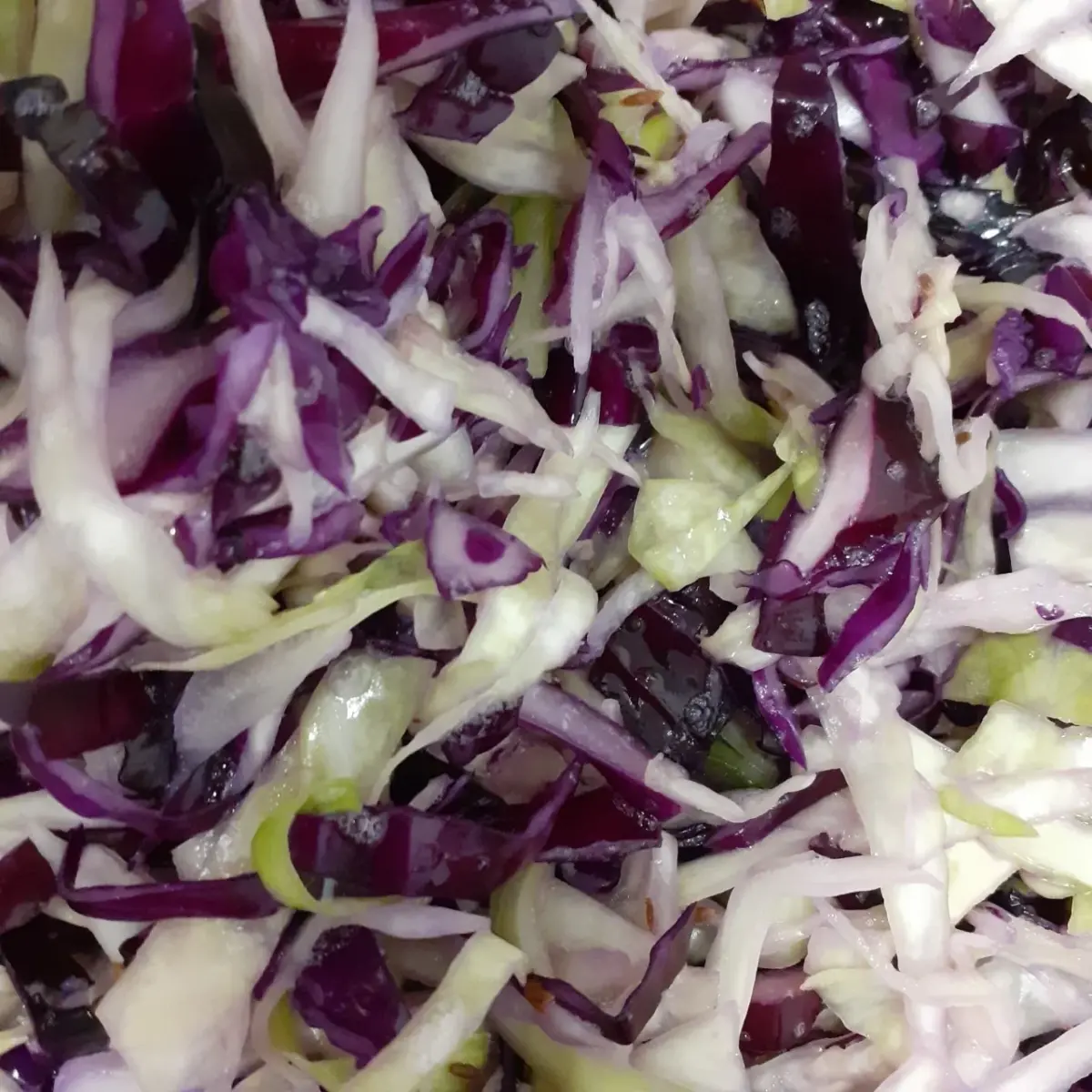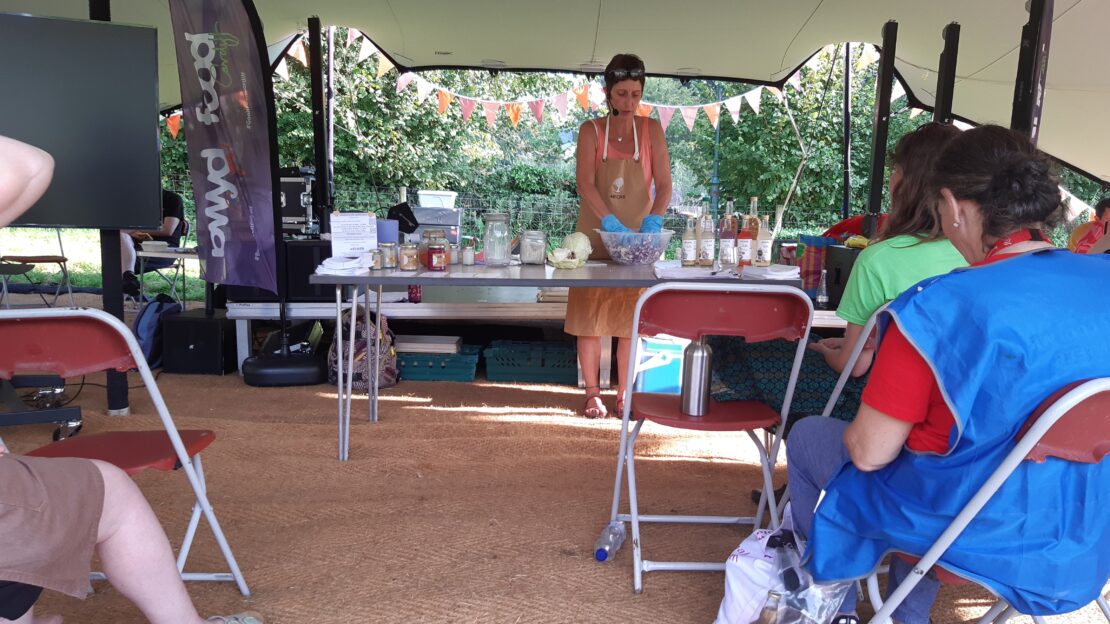As part of our Good Food Zone programme at the Amgueddfa Cymru Food Festival Laure Boutrais ran a fermentation demo for Food Cardiff.
Laure runs Absorb, making water kefir and sauerkraut which she sells at markets and independent retailers around the city and beyond.
Fermented foods are seen as beneficial for gut health and are a good way to get more vegetables into your diet – or to cut down on wasting vegetables by preserving them.
Here, Laure shares three of her recipes that she demonstrated during the Good Food Cardiff Autumn Festival for you to try at home:
Raw Kraut
Ingredients
1 kg organic white or red cabbage
10 g of unrefined sea salt
Half a teaspoon of your favourite seeds like caraway, fennel or cumin.
Method
- Remove the soft leaves around the cabbage and keep them for the end.
- Cut your cabbage in half and remove the core (keep it as you can use it at the end). Shred it as thinly as you like, sideways (the thinner it is, the quicker it will get the salt in to ferment, but I like it thicker as it remains crunchier to my taste).
- Put in a big bowl and sprinkle the salt over it.
- Add the seeds and start massaging the cabbage, really crunching those leaves until they start releasing their moisture and the shreds become submerged with cabbage juice. It can take about 10 minutes and the volume should go right down to half. During this process, have a taste and check if it is salty enough to your taste. It’s best to add more salt later than making it too salty!
- Then pack the cabbage into a sterilized jar, make sure there are no air bubbles and that the cabbage is covered with its juice. Cover the top with the soft cabbage leaf and use the stalk to push the cabbage down into the liquid and close the jar.
- Leave at room temperature for at least 5 days, depending on how crunchy and sauer you like it. You may need to remove some of the juice as it starts bubbling in the jar.
- Then either transfer the kraut into smaller pots or refrigerate and consume within the next three months.

Lacto-fermented Vegetables
All you need is salt and water. Dissolve 30g salt in 1 litre of boiling water and leave it to cool down (make sure it is cold before you use it otherwise it will make your veg go soft!)
Cut your veg into chunks. I like to cube carrots and beetroots. You can also use cauliflower florets or slices of leeks. Cucumbers and courgettes can also be lacto-fermented, cut lengthways – as for mushrooms it’s good to boil them for five minutes, rinse them and let them cool down before using. You can also use green tomatoes or gooseberries – just fill up a jar with one sort or a mix
It can be nice to add flavours to your ferments. Peppercorns, fenugreek, juniper or either fresh or dried herbs like rosemary, sage, chives or even bits of ginger or garlic will enhance your ferments.
Once you have layered your vegetables and flavours, top up with the cooled brine, make sure all veg is covered by the salty water – you can push them down with a glass cup or some kind of weight then lock the jar. You can also add kefir water or miso with the brine for extra ferments and flavours. Use your imagination and just try things!
Leave in the back of your cupboard for a good 10 days to two weeks. Check the flavours – it should taste vinegary and will be ready to consume. You can leave in cupboard for a bit longer or put in the fridge.
Simple Kimchi
Ingredients
1 kg chinese cabbage
80g sea salt or kosher salt (see below)
Water, preferably distilled or filtered
1 tablespoon grated garlic (5 to 6 cloves)
1 teaspoon grated peeled fresh ginger
1 teaspoon granulated sugar
2 tablespoons fish sauce or 3 tablespoons water (I use Tamari)
1 to 5 tablespoons Korean red pepper flakes (gochugaru)
200g radish or daikon, peeled and cut into matchsticks
4 medium onions, trimmed and cut into 1-inch pieces
Method
- Cut the cabbage lengthwise through the stem into quarters. Cut the cores from each piece. Cut each quarter crosswise into 2-inch-wide strips. Salt the cabbage. Place in a large bowl and sprinkle with the salt.
- Using your hands, massage the salt into the cabbage until it starts to soften. Add enough water to cover the cabbage. Put a plate on top of the cabbage and weigh it down with something heavy, like a jar or can of beans. Let stand for one to two hours.
- Rinse and drain the cabbage under cold water 3 times. Set aside to drain in a colander for 15 to 20 minutes.
- Meanwhile, make the spice paste: Rinse and dry the bowl you used for salting. Add the garlic, ginger, sugar, and fish sauce, shrimp paste, or water and stir into a smooth paste. Stir in the gochugaru, using 1 tablespoon for mild and up to 5 tablespoons for spicy (I like about 3 1/2 tablespoons); set aside until the cabbage is ready.
- Combine the vegetables and spice paste: Gently squeeze any remaining water from the cabbage and add it to the spice paste. Add the radish and scallions. Mix thoroughly. Using your hands (use gloves), gently work the paste into the vegetables until they are thoroughly coated.
- Pack the kimchi into the jar: Pack the kimchi into a 1 litre jar. Press down on the kimchi until the brine rises to cover the vegetables, leaving at least 1 inch of space at the top. Seal the jar.
- Let it ferment for one to five days: Place a bowl or plate under the jar to help catch any overflow. Let the jar stand at cool room temperature, out of direct sunlight, for one to five days. You may see bubbles inside the jar and brine may seep out of the lid. Check it daily and refrigerate when ready.
- When the kimchi tastes ripe enough for your liking, transfer the jar to the refrigerator. You may eat it right away, but it’s best after another week or two.



